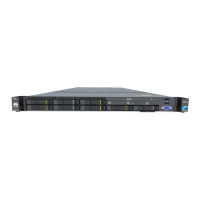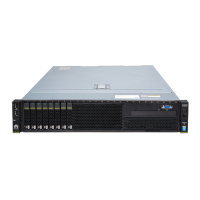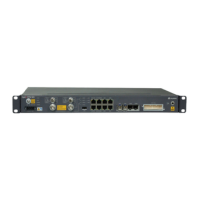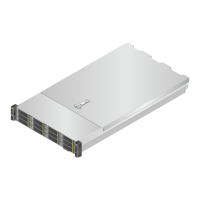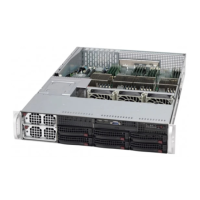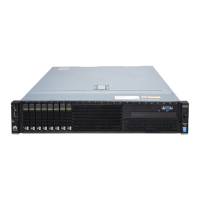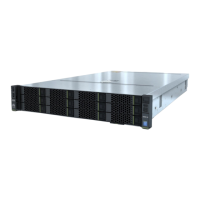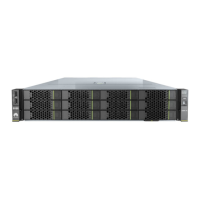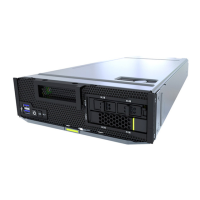Do you have a question about the Huawei E9000 and is the answer not in the manual?
Describes the overview, functions, structure, installation, and configuration methods of the E9000.
Identifies the target readers for this document, including engineers and technicians.
Defines the meaning of symbols used in the document for hazard warnings and notes.
Provides guidelines for safe installation and operation of hardware, emphasizing compliance and caution.
Details safety measures for personnel, including certification, reporting, and protective gear.
Covers safe practices for using tools, power cables, and handling equipment during operations.
Guidelines for safely transporting hardware, including packaging and logistics requirements.
Specifies maximum handling weights according to different standards for personal safety.
Describes the E9000's capabilities, including compute node models, density, switching, and management features.
Describes the physical appearance of the E9000 chassis, including front panel components and LCD.
Explains the meaning of various indicators on the E9000 chassis for status monitoring.
Details the physical structure and components of the E9000 chassis, illustrated with a hardware structure diagram.
Describes the principles, components, and configuration of the E9000 chassis power supply system.
Explains the E9000's heat dissipation system, including fan modules and capability.
Covers security solutions for compute nodes, switch modules, and management modules.
Provides physical specifications for the E9000 chassis, PSUs, and fan modules, including dimensions.
Provides an overview of the E9000 installation process and prerequisites, including documents and tools.
Describes the procedure for unpacking the E9000 chassis, including checking packaging and components.
Details how to remove fan modules, PSUs, management modules, and switch modules before chassis installation.
Provides instructions for installing the E9000 chassis in a cabinet, including mounting ear adjustments.
Describes the procedure for installing fan modules into the E9000 chassis slots.
Details the procedure for installing AC and DC PSUs into the E9000 chassis, including slot determination.
Provides instructions for installing management modules (MM910) into the E9000 chassis slots.
Describes the procedure for installing switch modules or pass-through modules into the E9000 chassis.
Details the process for installing a half-width compute node, including unpacking and slot preparation.
Provides instructions for installing a full-width compute node, including unpacking and slot preparation.
Describes how to connect PGND cables and power cables to the E9000 chassis and PSUs.
Details the procedure for installing signal cables, including network, serial, and optical cables.
Provides check items to verify the chassis and cable installation against requirements.
Describes the procedure for powering on the E9000 chassis after installation, including cable checks.
Details the procedure for powering off the E9000 chassis before maintenance or part replacement.
Outlines the initial configuration process for the E9000, involving management, compute, and switch modules.
Provides default IP addresses and user information for management modules (MM910s).
Describes the steps to configure management modules (MM910) via WebUI, including security and basic data settings.
Details the configuration process for compute nodes, including password changes, IP settings, and BIOS configuration.
Explains how to configure switch modules for module switching functionality, including initial password and data settings.
Provides instructions for replacing management modules (MM910), including active/standby switchover.
Describes how to replace compute nodes, including powering off, removal, and installation procedures.
Details precautions, preparations, and procedures for replacing switch modules, including license transfer.
Provides instructions for replacing PSUs, including power supply type check and cable removal.
Describes the procedure for replacing a fan module, including removal and installation steps.
Details how to replace the chassis intelligent display, considering captive screw status.
Provides instructions for replacing the entire chassis, including module removal and powering off.
Covers requirements for server capacity expansion, including component compatibility and authorized personnel.
Describes how to add and upgrade compute nodes, switch modules, fan modules, and PSUs.
Details adding components like CPUs, DIMMs, and hard disks to compute nodes, including compatibility checks.
Describes label types and locations for equipment, cables, and components.
Provides specifications for creating printed and hand-written labels for clarity and legibility.
Details how to attach labels to PGND, power, and signal cables, ensuring proper placement and orientation.
Covers cable layout guidelines, including routing, binding, and spacing requirements within the cabinet.
Details installation requirements for PGND and power cables, including length measurement and PDU connection.
Provides requirements for installing signal cables, including optical cables, Ethernet cables, and routing considerations.
Lists precautions for transporting equipment, including logistics company selection and package handling.
Describes methods for unloading equipment based on vehicle type, listing required tools and references.
Details methods for moving equipment, including pallet truck, forklift, and hand-moving techniques.
Describes the overview, functions, structure, installation, and configuration methods of the E9000.
Identifies the target readers for this document, including engineers and technicians.
Defines the meaning of symbols used in the document for hazard warnings and notes.
Provides guidelines for safe installation and operation of hardware, emphasizing compliance and caution.
Details safety measures for personnel, including certification, reporting, and protective gear.
Covers safe practices for using tools, power cables, and handling equipment during operations.
Guidelines for safely transporting hardware, including packaging and logistics requirements.
Specifies maximum handling weights according to different standards for personal safety.
Describes the E9000's capabilities, including compute node models, density, switching, and management features.
Describes the physical appearance of the E9000 chassis, including front panel components and LCD.
Explains the meaning of various indicators on the E9000 chassis for status monitoring.
Details the physical structure and components of the E9000 chassis, illustrated with a hardware structure diagram.
Describes the principles, components, and configuration of the E9000 chassis power supply system.
Explains the E9000's heat dissipation system, including fan modules and capability.
Covers security solutions for compute nodes, switch modules, and management modules.
Provides physical specifications for the E9000 chassis, PSUs, and fan modules, including dimensions.
Provides an overview of the E9000 installation process and prerequisites, including documents and tools.
Describes the procedure for unpacking the E9000 chassis, including checking packaging and components.
Details how to remove fan modules, PSUs, management modules, and switch modules before chassis installation.
Provides instructions for installing the E9000 chassis in a cabinet, including mounting ear adjustments.
Describes the procedure for installing fan modules into the E9000 chassis slots.
Details the procedure for installing AC and DC PSUs into the E9000 chassis, including slot determination.
Provides instructions for installing management modules (MM910) into the E9000 chassis slots.
Describes the procedure for installing switch modules or pass-through modules into the E9000 chassis.
Details the process for installing a half-width compute node, including unpacking and slot preparation.
Provides instructions for installing a full-width compute node, including unpacking and slot preparation.
Describes how to connect PGND cables and power cables to the E9000 chassis and PSUs.
Details the procedure for installing signal cables, including network, serial, and optical cables.
Provides check items to verify the chassis and cable installation against requirements.
Describes the procedure for powering on the E9000 chassis after installation, including cable checks.
Details the procedure for powering off the E9000 chassis before maintenance or part replacement.
Outlines the initial configuration process for the E9000, involving management, compute, and switch modules.
Provides default IP addresses and user information for management modules (MM910s).
Describes the steps to configure management modules (MM910) via WebUI, including security and basic data settings.
Details the configuration process for compute nodes, including password changes, IP settings, and BIOS configuration.
Explains how to configure switch modules for module switching functionality, including initial password and data settings.
Provides instructions for replacing management modules (MM910), including active/standby switchover.
Describes how to replace compute nodes, including powering off, removal, and installation procedures.
Details precautions, preparations, and procedures for replacing switch modules, including license transfer.
Provides instructions for replacing PSUs, including power supply type check and cable removal.
Describes the procedure for replacing a fan module, including removal and installation steps.
Details how to replace the chassis intelligent display, considering captive screw status.
Provides instructions for replacing the entire chassis, including module removal and powering off.
Covers requirements for server capacity expansion, including component compatibility and authorized personnel.
Describes how to add and upgrade compute nodes, switch modules, fan modules, and PSUs.
Details adding components like CPUs, DIMMs, and hard disks to compute nodes, including compatibility checks.
Describes label types and locations for equipment, cables, and components.
Provides specifications for creating printed and hand-written labels for clarity and legibility.
Details how to attach labels to PGND, power, and signal cables, ensuring proper placement and orientation.
Covers cable layout guidelines, including routing, binding, and spacing requirements within the cabinet.
Details installation requirements for PGND and power cables, including length measurement and PDU connection.
Provides requirements for installing signal cables, including optical cables, Ethernet cables, and routing considerations.
Lists precautions for transporting equipment, including logistics company selection and package handling.
Describes methods for unloading equipment based on vehicle type, listing required tools and references.
Details methods for moving equipment, including pallet truck, forklift, and hand-moving techniques.
| Form Factor | 12U chassis |
|---|---|
| Blade Slots | 16 half-width slots or 8 full-width slots |
| Switch Modules | GE, 10GE, and IB switches |
| Management Modules | Two hot-swappable management modules for redundancy |
| Power Supply | Supports up to 6 hot-swappable power supply units (PSUs) |
| Cooling | Redundant hot-swappable fan modules |
| Processor Options | Intel Xeon E5-2600 v3/v4 series processors (depending on blade type) |
| Memory Capacity | Up to 1.5 TB per blade |
| Storage Options | SAS/SATA/SSD options in blades |
| Networking | 10GE/40GE networking options |
| Management | Huawei iBMC (Intelligent Baseboard Management Controller) |
| Operating System Support | Red Hat Enterprise Linux, SUSE Linux Enterprise Server, Windows Server, VMware ESXi |
